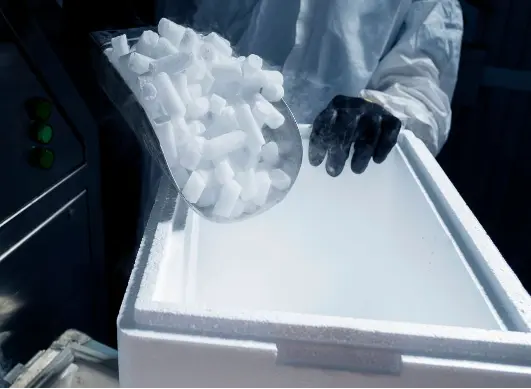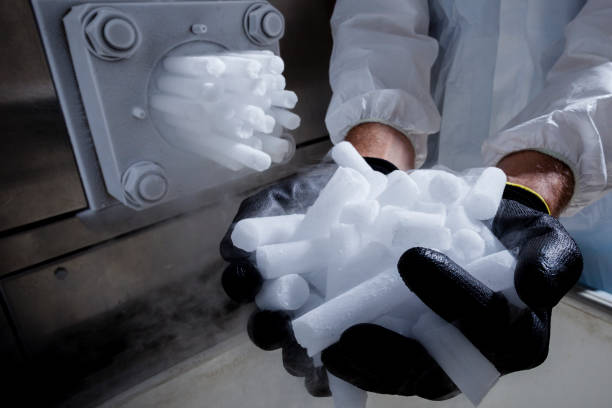What is Dry Ice?

Dry ice, also known as cardice, is a remarkable material that has many uses in various industries. It is a solid form of carbon dioxide and is commonly used in shipping and transportation, food and beverage preservation, cleaning and blasting, and special effects and entertainment. In this article, we will discuss what dry ice is, how it is made, its uses, and safety precautions when using it.
Dry ice is a solid form of carbon dioxide that is used in various industries. It is created by compressing and cooling carbon dioxide gas until it turns into a solid. Dry ice is extremely cold, with a temperature of -78.5 degrees Celsius (-109.3 degrees Fahrenheit), and sublimates (turns into gas) when exposed to room temperature.
How is Dry Ice Made?

Dry ice is made by compressing and cooling carbon dioxide gas until it liquefies. The liquid carbon dioxide is then released into a chamber where it expands and cools, turning into a solid. The solid carbon dioxide is then compressed into blocks, pellets, or slices, depending on the intended use.
Uses of Dry Ice:

a. Food and Beverage Preservation:
Dry ice is commonly used in the food and beverage industry to preserve and transport perishable items. It is particularly useful for keeping food and drinks cold during transportation or for storing items in freezers. Dry ice is also used in the production of ice cream and other frozen treats.
b. Shipping and Transportation:
Dry ice is commonly used in the shipping and transportation industry to keep items cold during transit. It is particularly useful for shipping medical and scientific specimens that require a specific temperature range to remain viable.
c. Cleaning and Blasting:
Dry ice is also used for cleaning and blasting applications. Dry ice blasting is a cleaning method that uses dry ice pellets to remove dirt, grime, and other contaminants from surfaces without damaging the underlying material. It is particularly useful for cleaning industrial machinery and equipment.
d. Special Effects and Entertainment:
Dry ice is often used in special effects and entertainment. It is commonly used to create a thick, fog-like effect in stage productions, music videos, and movies. Dry ice is also used to create bubbling effects in drinks and cocktails.
Safety Precautions When Using Dry Ice:

When using dry ice, it is important to take proper safety precautions to prevent injury or damage. Dry ice can be extremely cold, and direct contact with skin can cause frostbite. It is also important to ensure that the area where dry ice is used is well-ventilated to prevent the buildup of carbon dioxide gas, which can be dangerous in high concentrations.”Unlocking the Powerful Uses of Dry Ice: From Food Preservation to Special Effects”.Dry ice is a versatile substance commonly used for various applications, including cooling, shipping, and special effects. However, its low temperature of around -78.5°C (-109.3°F) makes it potentially hazardous if not handled with care. When using dry ice, safety precautions are paramount to prevent injuries and accidents.One of the primary safety concerns with dry ice is its potential for frostbite and cold burns. Direct contact with dry ice can cause immediate damage to the skin and underlying tissues. Therefore, it’s crucial to handle dry ice with insulated gloves or tongs. When storing or transporting dry ice, always use well-ventilated containers to prevent the buildup of carbon dioxide gas, which can displace oxygen and pose a suffocation risk.In addition to personal protection, it’s essential to use dry ice in well-ventilated areas. Dry ice sublimates (converts from a solid to a gas) and releases carbon dioxide gas, which can accumulate in enclosed spaces and displace oxygen. Adequate ventilation helps maintain a safe oxygen level and prevents the risk of asphyxiation. When using dry ice for shipping or storage, always label containers clearly to alert others to its presence and potential hazards. By following these safety precautions, you can harness the benefits of dry ice while minimizing the associated risks.
What are the Hazards of Dry Ice?
In this section, you can discuss the potential hazards associated with dry ice, such as its extreme cold temperature (-78.5 °C or -109.3 °F) and the fact that it sublimates (turns directly from solid to gas) without leaving any liquid residue. You can also explain how to handle dry ice safely, including using protective gloves, goggles, and clothing, and ventilating the area where dry ice is used or stored.”Danger Lurks: The Hazards of Mishandling Dry Ice and How to Stay Safe”.
Conclusion:
Dry ice is a versatile material that has many uses in various industries. It is created by compressing and cooling carbon dioxide gas until it turns into a solid. Dry ice is commonly used in food and beverage preservation, shipping and transportation, cleaning and blasting, and special effects and entertainment. When using dry ice, it is important to take proper safety precautions to prevent injury or damage.Dry ice is an incredibly versatile material that can be used in a variety of industries, from shipping and transportation to special effects and entertainment. Its ability to keep things cold and create unique effects makes it a valuable tool for many businesses. However, it is important to remember that dry ice can also be dangerous if not handled properly. Direct contact with the skin can cause frostbite, and exposure to high concentrations of carbon dioxide gas can be harmful. As long as proper safety precautions are taken, dry ice can be a fantastic resource for those in need of its unique properties.
Table of Contents:
Introduction
1. What is Dry Ice?
2. How is Dry Ice Made?
3. Uses of Dry Ice
a. Food and Beverage Preservation
b. Shipping and Transportation
c. Cleaning and Blasting
d. Special Effects and Entertainment
4. Safety Precautions When Using Dry Ice
5. Conclusion
“The Versatile Uses of Dry Ice: A Comprehensive Guide”
“Exploring the Benefits and Precautions of Using Dry Ice”
“From Food Preservation to Special Effects: The Many Applications of Dry Ice”
“Everything You Need to Know About Dry Ice: Uses and Safety Tips”
“The Science Behind Dry Ice: How It’s Made and Where It’s Used”


